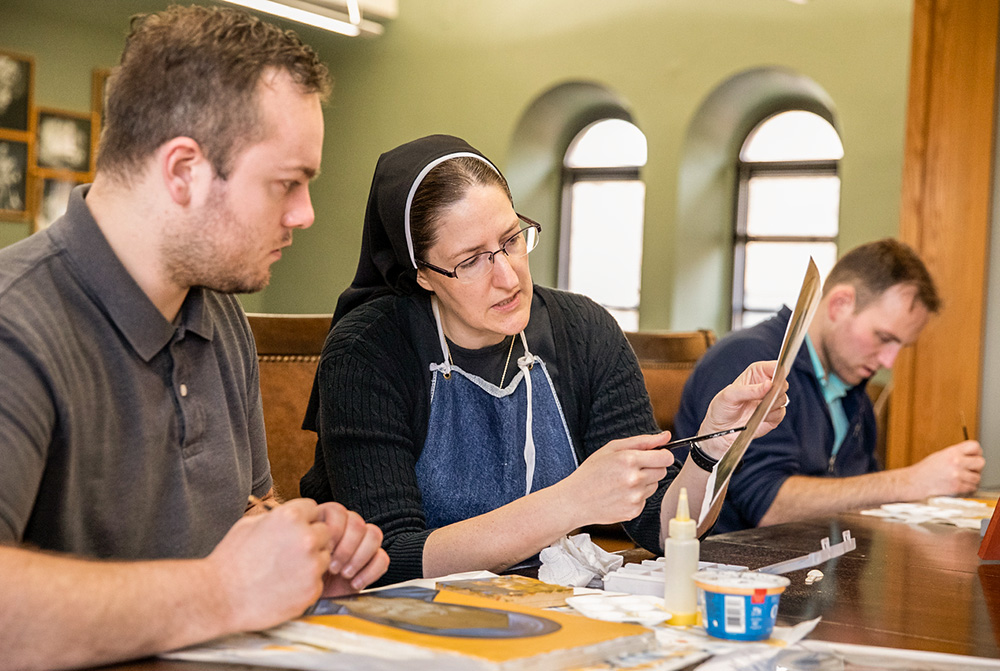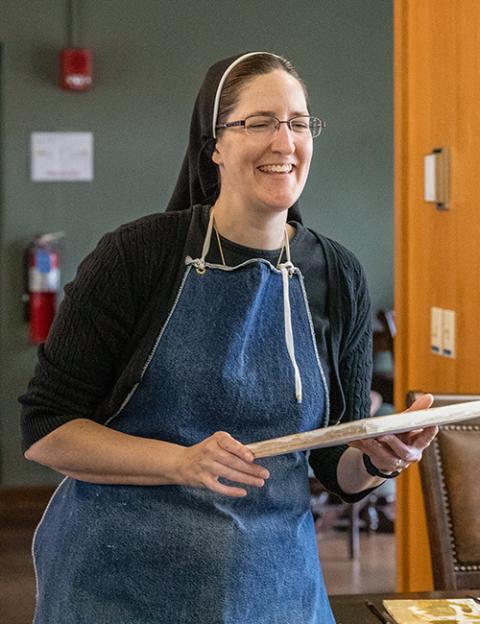
Benedictine Sr. Jeana Visel instructs propaedeutic-year seminarians in icon painting at St. Meinrad Seminary and School of Theology in Indiana. (Krista Hall)
Benedictine Sr. Jeana Visel has been a member of the Monastery Immaculate Conception in Ferdinand, Indiana, since 2003 and life professed since 2010. The Sisters of St. Benedict there serve in a variety of ministries, and Visel's ministry is as an iconographer. She paints icons and teaches courses on their history and how to paint them at St. Meinrad Seminary and School of Theology in Indiana. She is also the dean of the School of Theology programs at St. Meinrad.
She wrote a book, Icons in the Western Church: Toward a More Sacramental Encounter, about a growing interest in icons in the Western church and how Roman Catholics after Vatican II can find them both spiritually helpful and challenging.
Visel spoke to Global Sisters Report about her approach to icons and how Catholics can use them as a spiritual practice.
_____
GSR: How did you become an iconographer?
Visel: I had a good art teacher in middle and high school, but I was never the kind of person who had a vision to share with the world. I wasn't going to go to art school.
In 2006, a friend gave me Peter Pearson's icon painting workbook for Christmas. You need technical ability, but it's also about prayer and spiritual practice and helping other people pray.
I initially thought it was just copying, but it's not just copying.
In 2008, I was living in Louisville, and I went to an icon painting workshop at an Orthodox church with Ksenia Pokrovsky and Marek Czarnecki. My mind was just blown. There was so much to learn. As often as I could afford, I would do a workshop. I also did workshops with Pokrovsky's daughter, Anna Gouriev.
This coming fall, I'm going to start an icon painting certificate out of St. Vladimir's called Writing the Light with George Kordis, which is in the Greek style instead of Russian.
Advertisement
Your book is about Western Christians and icons. How do you think Western Christians can approach them?
We're a sacramental people. There's something about the concrete, about the image, that's needed to understand who God is.
Images are key to the religion. If you look at the catacombs, they're there.
In the West, we've tended to have a more dynamic tradition and a shift from the icon form during the Renaissance. Our relationship with art has tended to shift more toward an emphasis on the human world. The Eastern churches have tended to stay in the heavenly perspective.
We have different kinds of art that do different things. Liturgical art makes visible the dimensions of what we're doing at the liturgy, like the Last Supper. They're images that help us understand that bigger reality. It's good to have images in a church or a reconciliation room.
Another one is the devotional image, which is probably most of us when we think of icons; we think of an image of a saint or of Jesus. The purpose of devotional images is to help us prepare for the sacraments and give us a better disposition to allow that grace into our lives.
There are also catechetical images used to teach. Each type has its appropriate place.
After Vatican II, when the goal was to reclaim full participation in the liturgy and remove distraction, a lot of art was taken out. But actually, liturgical images are important. People have an innate sense of that.
People have been gravitating to images because we need images to help us understand. One of the principles of icons is they're reflecting the world of heaven. We've seen a greater emphasis on smells and bells and all that, because the world is distressing, and people want a reminder that heaven is real and God is real.
Icons are popular because of that. They say it's OK to believe in God. It's OK to enter into this experience. We're not cut off from the world of heaven, and saints are helping us.
It's also ecumenical because it connects us with Eastern churches and our roots.
How can a parish introduce icons?
It depends on what kind of art they already have. An educational presentation on images in church art, and how they're similar and different from other kinds of art, would be a good start.
A lot of us Anglo-Roman Catholics struggle with veneration, so helping people understand it's OK to venerate icons like we do with relics and the cross on Good Friday. People need a little introduction to that. You can try having an icon in a corner with candles nearby.
Some churches have a little stand in the entryway with an icon appropriate to where they are in the liturgical year, which is one way of introducing images as connected to liturgical time.
Bigger renovations will need more education.

Sr. Jeana Visel teaches an icon class to seminarians on March 2, 2023. (Krista Hall)
As a professor, how do you teach about icons to your students, both seminarians and future lay ministers?
Our resident rector has chosen to put images all over the walls. People are primed to be open to images because you can't help but notice.
The seminarians have an intensive spiritual formation week, so I've given an overview in the past. Now with the propaedeutic year, they have one quarter where they have a course on icon painting, four mornings a week, doing the whole process, starting with the board. I also offer a once-a-week elective.
When you're painting an icon, you're learning from the inside. It's a very physical experience, but it's also emotional. You're going to hit your limits. For people accustomed to being good on the first try, it can be hard. It's a master-and-apprentice model.
It's a human formation issue of accepting one's limits and that it's OK to ask for help.
It's also spiritual. We should be praying with every brushstroke, whether that be the Jesus Prayer, asking for the intercession of the saint we're painting, or praying for someone we know. I challenge them: Can you paint and pray at the same time? That's hopefully a transferable skill when you're sweeping or doing dishes.
For lay students, I teach a course based on my book, and I especially focus on how it can help or hinder ecumenical relations.
Do you have any advice for someone who wants to get into icon painting?
You can start with books, but it really does help to work with a real teacher at some point. There's no real replacement for an actual teacher.
Sometimes it's hard to find a good teacher, and there are some weird ones out there. People will attach all sorts of symbolic spiritual meaning to things. Be careful and discerning. Not everything has to be laden with pressure.
It's easier to find good iconographers with the internet, and there are various sacred arts programs cropping up here and there.
When you find a good teacher, stick with them. Part of that is humility — it's not just about me. It's like learning to translate Scripture. You want to be faithful to the tradition. Working with a teacher keeps us from going too far off track in our own little world.






